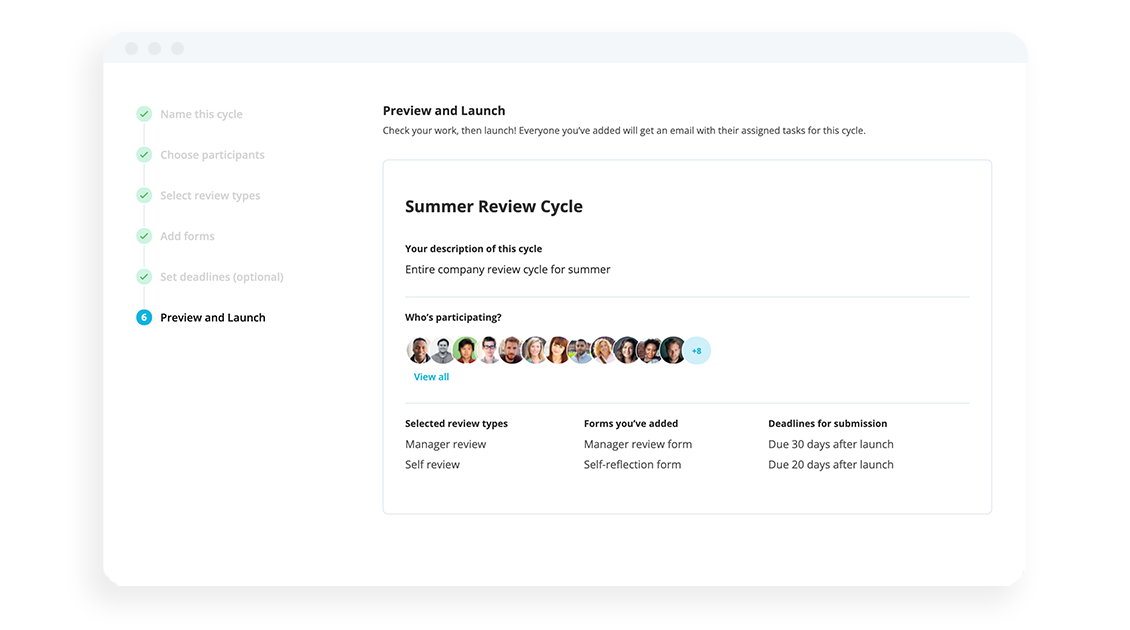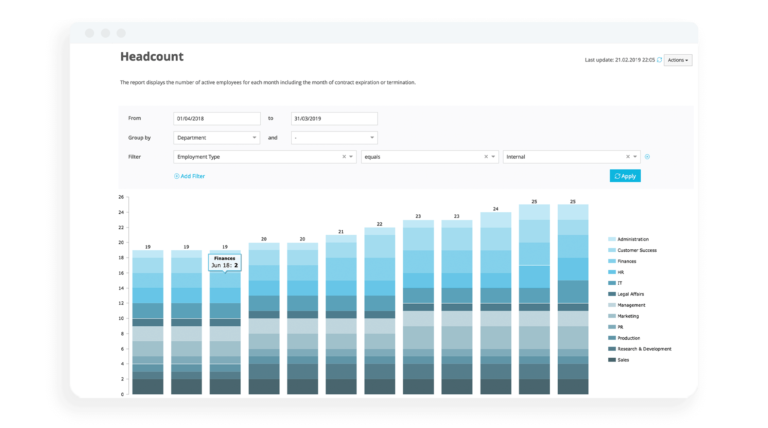
People Strategy Guidebook
A free guide to help power your next great people strategy.
Download our guide to developing your organization’s own people strategy today.The Strategic Human Resource Planning (HRP) Guide
Human resource planning lets you make the most of your company’s most important resource: people. Read on for our full guide to strategic HRP.
Planning around your workforce starts with a great people strategy.What is human resource planning (HRP)?
Human resource planning (HRP) is the process of assessing a company’s current workforce against its future needs. It allows organisations to ensure they’ll always have the people they need to meet their goals.
What is the goal of human resource planning?
The goal of human resource planning is to ensure an organisation has the human resources it needs to meet its short and long-term objectives.
HRP can help businesses to avoid both staffing shortages and expensive surpluses. It also enables them to make better use of their employees by ensuring everyone is working to their strengths.
When done right, human resource planning allows HR teams to make smarter, data-driven HR decisions that are in line with their organisation’s core strategy.
How do organisations make use of human resource planning?
Here are some examples of how an organisation might use human resource planning to meet its future goals.
Human resource planning example #1: Opening a new branch
An organisation is planning to open an office in a new geographic region. This will involve hiring around 200 full and part-time employees to work in the new location — a big operation that will involve a lot of work for the HR team.
First, they’ll need to work with the organisation’s leadership to determine exactly what roles they need to recruit for. They’ll also need to spend time learning about the labour laws and regulations that apply in the new location, and explore the local labour market to figure out the best ways of sourcing and attracting local talent.
Lastly, the HR team will also need to plan to onboard a large number of employees at the same time — which will take some careful planning. They’ll likely need to coordinate with other departments, like IT and legal, to facilitate this mass onboarding and create the training and onboarding materials they’ll need.
Human resource planning example #2: Preparing for upcoming retirements
An organisation’s HR team realises that a number of senior employees are approaching retirement age and will likely leave the workforce in the next few years. Because these employees hold a lot of important knowledge about the company and its operations, their departure could cause significant disruption.
In this situation, one form of human resource planning that could be useful is succession planning. This is when an organisation identifies potential internal candidates for leadership roles and develops them so they’re ready to replace leaders when they leave.
To do this, HR should work with department leaders to identify the key skills required for the roles and look for employees who share some of those skills. They could then fill any knowledge or skill gaps through training, mentoring and work shadowing.
When the employees in question do retire, the company will have prepared successors who will be ready to step into their roles.
Four steps in the human resource planning process
The human resource planning process can broadly be broken down into four key steps:
Analysing the current situation | Assessing the organisation’s workforce as it is today, including the number of employees and their roles, skills and knowledge. |
Making predictions about the future | Determining what will change in the near and more distant future, including internal and external factors that could impact the company’s HR needs. |
Conducting a gap analysis | Assessing the gap between the organisation’s current situation and its future needs. |
Developing and implementing an HR plan | Creating a plan to help the company meet its goals through HR initiatives like recruitment, training, redeployment of employees and budget allocation. |
We’ll go into each of these steps in more detail below.
1. Analysing your current workforce
The first step in the human resource planning process is to analyse the current state of your workforce. This means considering factors such as:
How many employees you have overall
How many employees you have in each department
How many employees hold each job title
The age of your current workforce (how many employees are approaching retirement)
Performance levels across the organisation
The skills, qualifications and education level of your employees
There are a number of ways to uncover this information. First, you could look into your HRIS data to gather basic information like the total number of employees in your organisation and how many work in each department.
You could also look at data from past performance reviews, or conduct employee self-evaluations and interviews with managers or department heads. Lastly, building an organisational chart can be a good way to get a visual overview of what your organisation looks like.
2. Forecasting the company’s future needs
You’ll then need to make predictions about the human resources your company will need in the future. There are a number of different internal and external factors to consider, including:
New products and services your company plans to launch
Planned changes to your workforce through retirements, layoffs and transfers
Potential mergers, acquisitions, moves or expansions
Projected turnover of employees based on current rates
Increased labour costs
Technological advancements that might change the way your company operates
You’ll need to work with your company’s leadership to predict how each of these factors will affect your organisation. Then, think about how many employees you’ll need (and the skills, knowledge and education levels they’ll need to have) in order to meet these future challenges as an organisation.
3. Conducting a gap analysis to guide future actions
The next stage is to analyse the gap between your organisation’s current resources and your future needs. For example, if you plan to introduce a new piece of technology but don’t yet have anyone qualified to manage it, you’ll need to fill that skills gap either by recruiting new employees or training the ones you have.
During this process, you might ask yourself questions like:
Do we need to hire new employees? How many? Full-time or part-time? With what skills?
Can we implement training to better prepare our current employees? What skills do we need to develop in house?
Can we redeploy current employees to new positions? Which ones?
Are our current employees working to their strengths?
Do we need to adapt our HR processes to accommodate the organisation’s future needs?
4. Developing and implementing an HR plan
Lastly, you’ll need to develop a clear, step-by-step plan that will enable you to meet your goals as an organisation. The answers to the questions you asked yourself in the gap analysis stage will guide you as you create and roll out your plan.
For example, here are a few things you might decide to do as an HR team:
Find and attract new employees
Deliver targeted training
Reassess your benefits programmes
Adapt your performance management process
Work on the company culture
Discover a New Partner in Workforce Planning

An HR software can be your greatest asset when it comes to planning out the future of your workforce, and your business. Speak with an expert today.
Book your demoBest practices for strategic human resource planning
Human resource planning can help you to ensure your organisation will always have the people it needs to meet its goals. Here are some best practices to follow for the best chance of success.
Watch what your competitors are doing
Your competitors are likely facing some of the same challenges and opportunities that you are. And many of them are also going through the same process of determining what their future needs will look like.
You can get an insight into what your competitors are doing by checking out their LinkedIn and job pages to find out what roles and skills they’re hiring for. You can also use LinkedIn to explore their current employees’ skills — and find out if they have something you’re currently missing.
Invest in employee retention
Human resource planning is all about planning for the future. But your plans could be blown apart if your best employees leave and take their skills and knowledge with them. That means you’ll need to put strategies in place to boost retention and keep your people for longer.
A good way to start is by conducting regular employee engagement surveys, which can help you spot problems before they go too far and leads to employees leaving. It’s also a good idea to conduct exit interviews whenever an employee does leave. This helps you to find out exactly why people are leaving, and find ways to prevent it in the future.
For example, if large numbers of people are leaving because they feel they have no way to progress within the organisation, this might be something to address in your human resource plan going forward.
Review and evaluate your plan regularly
Human resource planning is all about planning for the future — but no one can predict everything. If circumstances change, you should be prepared to re-evaluate your plan.
You might also find that strategies you develop in the planning stage don’t have the impact you expected. In this case, it’s important to reassess and adjust your processes.
It’s also important to set key metrics by which you’ll measure the success of your plan early on in the process. That way, you’ll be able to tell if your strategy isn’t working as expected and adjust it accordingly.
Finding time for strategic HR
Human resource planning is a vital part of overall strategic human resource management. It helps organisations to stay ahead of market changes, new technology and other factors that can impact performance. But it also takes a lot of time and focus — which HR teams often don’t have.
Personio is an all-in-one HR system that can simplify, automate and streamline repetitive tasks, giving your HR team the time they need to focus on strategic initiatives like HR planning. Plus, Personio’s analytics and reporting features give you access to the data you need to truly understand what your workforce looks like.
In other words, Personio makes it easier to understand your workforce and make confident, data-driven HR decisions. Want to learn more? Book your free demo today.
